
面向路径查询的室内语义建模
面向路径查询的室内语义建模
Indoor Semantic Modeling to Support Path-Finding
Sisi Zlatanova、Liu Liu 等编写
Walter Yu 译
1、室内导航
导航与位置服务是GIS领域发展很快的应用之一。目前,室内导航或室内外无缝导航得到人们的广泛关注。由于人们绝大部分时间都处在室内空间(如图1所示),当人们在复杂的大型室内环境时往往需要类似室外导航的许多应用服务。
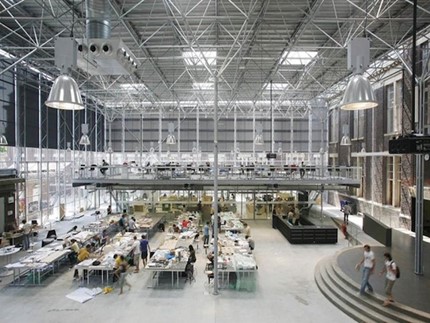
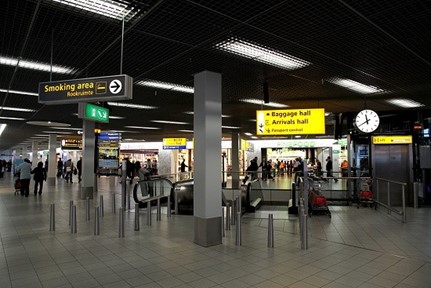
图1 复杂室内空间示例
2、存在问题
在室内数据获取、室内建模和用户个性化路径规划等方法存在许多挑战。虽然已经有一些不同类型的3D几何建筑模型以及面向不同目的的语义模型(如CityGML、BIM),但它们缺乏支持大量不同类型用户室内导航服务的有效信息。此外,由于导航网络和导航语义的差异,导致有些情况下室外路径规划方法难以完全应用在室内环境中。
3、室内语义建模研究
Liu Liu 博士和Sisi Zlatanova教授研究了面向室内导航的语义建模,特别是针对复杂室内环境。他们提出了一种语义建模方法,叫做Indoor Navigation Space Model (INSM),与任意指定类型的建筑物划分密切相关,如图2所示。它不仅定义了支持导航的所有需要的建筑要素,而且与建筑组件(如房间、门、楼梯灯)的几何进行关联。
INSM的一个优点之一就是能够用于几乎所有类别的几何模型。INSM的基本语义包括Navigable Space Cell(如房间或空间),简称NSC,Opening(如门或窗户),Obstacles(如桌子、护栏、其他家具等)。NSC的重要概念包括:1)支持水平移动的水平单元(Horizontal Unit),包括水平连接空间(如走廊)和End(仅仅连接了一个其他的房间);2)支持上下移动的垂直单元(Vertical Unit),如楼梯或电梯;3)垂直连接空间(Vertical Connector),它是一种特殊的水平单元,表达了其他水平单元和垂直单元。基于INSM的语义,就可以提取出路径模式(path pattern),并利用路径模式支持路径查询。
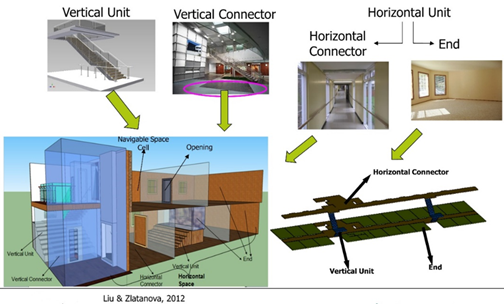
图2 Indoor Navigation Space Model (INSM)
他们也提供了一种从一些语义数据格式(如CityGML LoD4 或者BIM IFC)进行转换的方式。INSM中的语义不是许多现有的数据格式中所固有的要素。例如,可以将CityGML LoD4和BIM IFC两种类型的语义数据作为输入,用INSM的语义丰富这些数据。这种转换方式也支持包含有所需分类信息(如楼梯和电梯)的数字楼层平面图。
从CityGML数据中导出连通图(Connectivity Graph),如图3、4所示。
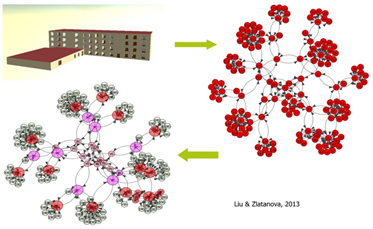
图3 生成逻辑模型
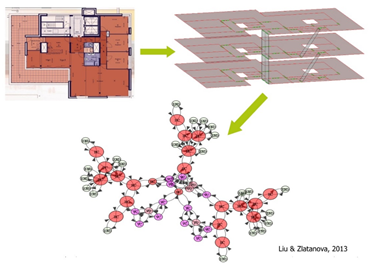
图4 从Floor Plans生成导航模型
从IFC模型中导出连通图(Connectivity Graph),如图5所示。
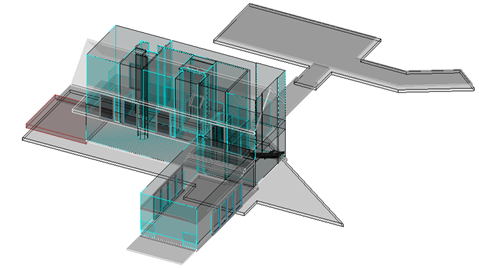
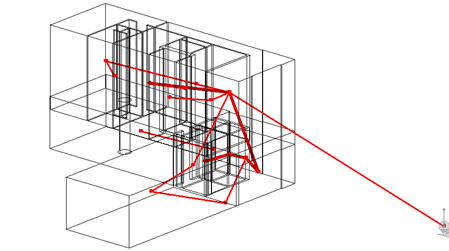
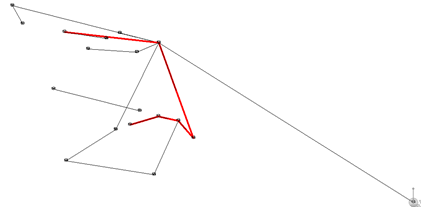
图5 从IFC模型中导出连通图
4、两层导航方法研究(Two level approach for navigation)
在INSM基础上,设计实现了一种两层室内路径规划方法。在粗略层(Coarse Level),从INSM中导出连通图,即逻辑路径;在详细层(Detailed Level),计算出没有障碍物房间的详细几何路径。通过结合室内语义建模和两层策略,能够生成用户个性化室内路径。在多路径选择时用户属性和偏好时重要的依据。
粗略层的路径,如图6所示。
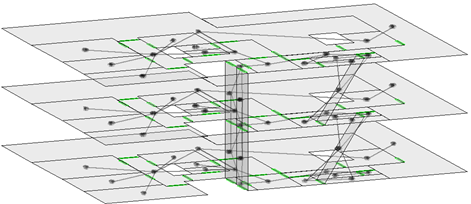
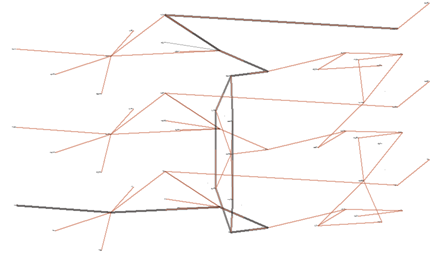
图6 粗略层路径
详细层路径,如图7所示。
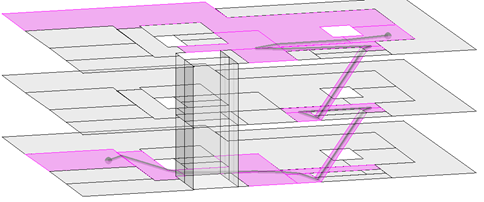
图7 详细层路径
5、参考资料
[1] https://3d.bk.tudelft.nl/projects/indoor/
[2] Multi-level path planning method. Qing Xiong, Qing Zhu, Sisi Zlatanova, Zhiqiang Du, Yeting Zhang and Li Yang Zeng. In Takashi Fuse and Masafumi Nakagawa (eds.), Int. Arch. Photogramm. Remote Sens. Spatial Inf. Sci., XL-4/W5, 2015, ISPRS Archives, ISPRS, 2015, pp. 19–23.
[3] Leveraging spatial model to improve indoor tracking. Liu Liu, Weilin Xu, Wouter Penard and Sisi Zlatanova. In Takashi Fuse and Masafumi Nakagawa (eds.), Int. Arch. Photogramm. Remote Sens. Spatial Inf. Sci., XL-4/W5, 2015, ISPRS Archives, ISPRS, 2015, pp. 75–80.
[4] A bim-oriented model for supporting indoor navigation requirements. Umit Isikdag, Sisi Zlatanova and Jason Underwood. Computers, Environment and Urban Systems 4(9), 2013, pp. 112–123.
[5] A two-level path-finding strategy for indoor navigation. Liu Liu and Sisi Zlatanova. Intelligent Systems for Crisis Management, Lecture Notes in Geoinformation and Cartography 2013, Springer Berlin Heidelberg, 2013, pp. 31–42.
[6] Modelling 3D topographic space against indoor navigation requirements. Gavin Brown, Claus Nagel, Sisi Zlatanova and Thomas Kolbe H.. In Jacynthe Pouliot, Sylvie Daniel and Frédéric Hubert (eds.), Progress and New Trends in 3D Geoinformation Sciences, Lecture Notes in Geoinformation and Cartography, Springer, Berlin Heidelberg, 2013, pp. 1–22.
[7] Improved geometric network model (ignm): a novel approach for deriving connectivity graphs for indoor navigation. Filippo Mortari and Sisi Zlatanova. ISPRS Ann. Photogramm. Remote Sens. Spatial Inf. Sci, 2014, pp. 45–51.
[8] Indoor space subdivision for indoor navigation. Marija Krūminaitė and Sisi Zlatanova. Proceedings of the Sixth ACM SIGSPATIAL International Workshop on Indoor Spatial Awareness, ISA '14, ACM, New York, NY, USA, 2014, pp. 25–31.
[9] Problems in indoor mapping and modelling. Sisi Zlatanova, G. Sithole, M. Nakagawa and Q. Zhu. ISPRS Acquisition and Modelling of Indoor and Enclosed Environments, 2013, pp. 63–68.
[10] A conceptual framework of space subdivision for indoor navigation. Sisi Zlatanova, Liu Liu and G. Sithole. Proceeding of ISA 2013 Proceedings of the Fifth ACM SIGSPATIAL International Workshop on Indoor Spatial Awareness, 2013, pp. 37–41.
[11] A 3D model based indoor navigation system for hubei provincial museum. W. Xu, M. Kruminaite, B. Onrust, H. Liu, Q. Xiong and Sisi Zlatanova. ISPRS Acquisition and Modelling of Indoor and Enclosed Environments, 2013, pp. 51–55.
[12] Multi-dimensional indoor location information model. Q. Xiong, Q. Zhu, Sisi Zlatanova, L. Huang, Y. Zhou and Z. Du. ISPRS Acquisition and Modelling of Indoor and Enclosed Environments, 2013, pp. 45–49.
[13] Generating navigation models from existing building data. Liu Liu and Sisi Zlatanova. Acquisition and Modelling of Indoor and Enclosed Environments 2013, ISPRS Archives Volume XL-4/W4, 2013, pp. 19–25.
[14] Space subdivision for indoor applications. Sisi Zlatanova and Liu Liu. Technical report, 2014.
About
Brain Inspired Navigation Blog
New discovery worth spreading on brain-inspired navigation in neurorobotics and neuroscience
Recent Posts
- How human, animals, robots encode and recall place?
- How the brain constructs time and space and how these are related to episodic memory?
- How environmental novelty modulate rapid cortical plasticity during navigation?
- How the Hippocampal Cognitive Map Supports Flexible Navigation?
- How the geometric structure and underlying circuit organization of hippocampal population dynamics facilitate both memory discrimination and generalization, enabling efficient and flexible learning?
Tags
Categories
- 3D Movement
- 3D Navigation
- 3D Path Integration
- 3D Perception
- 3D SLAM
- 3D Spatial Representation
- AI Navigation
- Bio-Inspired Robotics
- Brain Inspired Localization
- Brain-Inspired Navigation
- Cognitive Map
- Cognitive Navigation
- Episodic Memory
- Excerpt Notes
- Flying Vehicle Navigation
- Goal Representation
- Insect Navigation
- Learning to Navigate
- Memory
- Neural Basis of Navigation
- Path Integration
- Path Planning
- Project
- Research Tips
- Robotic Vision
- Self-Flying Vehicles
- Semantic Memory
- Spatial Cognition
- Spatial Cognitive Computing
- Spatial Coordinate System
- Spatial Learning
- Spatial Memory
- Spatial Resoning
- Time
- Unclassified
- Visual Cortex
- Visual Cue Cells
Links
- Laboratory of Nachum Ulanovsky
- Jeffery Lab
- BatLab
- The NeuroBat Lab
- Taube Lab
- Laurens Group
- Romani Lab
- Moser Group
- O’Keefe Group
- DoellerLab
- MilfordRobotics Group
- The Space and Memory group
- Angelaki Lab
- Spatial Cognition Lab
- McNaughton Lab
- Conradt Group
- The Fiete Lab
- The Cacucci Lab
- The Burak Lab
- Knierim Lab
- Clark Spatial Navigation & Memory Lab
- Computational Memory Lab
- The Dombeck Lab
- Zugaro Lab
- Insect Robotics Group
- The Nagel Lab
- Basu Lab
- Spatial Perception and Memory lab
- The Neuroecology lab
- The Nagel Lab
- Neural Modeling and Interface Lab
- Memory and Navigation Circuits Group
- Neural Circuits and Memory Lab
- The lab of Arseny Finkelstein
- The Epstein Lab
- The Theoretical Neuroscience Lab
- Gu Lab (Spatial Navigation and Memory)
- Fisher Lab (Neural Circuits for Navigation)
- The Alexander Lab (Spatial Cognition and Memory)
- Harvey Lab (Neural Circuits for Navigation)
- Buzsáki Lab
- Brain Computation & Behavior Lab
- ……